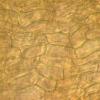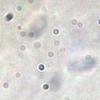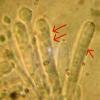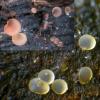
02-01-2026 17:43
MARICEL PATINOHi there, although I couldn't see the fruitbody, I

01-01-2026 18:35
Original loamy soil aside a artificial lake.The co

31-12-2025 19:27
Collected from loamy soil, at waterside (completel

30-12-2025 16:44
Pascal DucosBonjour,Une anamorphe rose stipitée, très nombre

30-12-2025 17:14
 Bernard CLESSE
Bernard CLESSE
Bonjour à toutes et tous,Pourriez-vous aider Albe
Orbilia de Ceratonia siliqua
Javier Ormad,
19-02-2011 21:17
Ascomata up to 2 mm in diameter. Dry raw impaired Ceratonia siliqua
Javier Ormad,
19-02-2011 21:18
Re:Orbilia de Ceratonia siliqua
Microscopy recognize that it is very poor, but ... ... ... .. say something. Cylindrical asci 22-26 x 3 microns with ascospores smooth, hyaline, of 2.5-4 x 1-1.5 microns. Paraphyses without providing clarity.
Microscopie reconnaître qu'il est très pauvre, mais ... ... ... .. dire quelque chose. Asques cylindriques 22-26 x 3 microns avec des ascospores lisses, hyalines, de 2,5-4 x 1-1,5 microns. Paraphyses sans fournir plus de clarté.
Microscopie reconnaître qu'il est très pauvre, mais ... ... ... .. dire quelque chose. Asques cylindriques 22-26 x 3 microns avec des ascospores lisses, hyalines, de 2,5-4 x 1-1,5 microns. Paraphyses sans fournir plus de clarté.
Javier Ormad,
19-02-2011 21:20
Hans-Otto Baral,
19-02-2011 22:31

Re:Orbilia de Ceratonia siliqua
Hi Javier
this is a Hyalorbilia (t. prismatica, short unstalked asci), and I strongly suspect you have H. ulicicola, a quite common but still undescribed species. Did you see the droplets at both spore ends?
Did this grow on a branch lying on the ground? I would much like to note date and locality, can you tell me?
You cannot get sharper photos of the spores? I looked at your metadata: With Canon Powershot your images should get better. 1/4 sec. shutter speed is much too long, then you easily get trembling and unsharp images. 1/30 is minimum. I think the aperture is the reason: 6 is much too high, try to reduce it as much as possible, 3 or lower. Tell me if you succeed.
thanks
Zotto
this is a Hyalorbilia (t. prismatica, short unstalked asci), and I strongly suspect you have H. ulicicola, a quite common but still undescribed species. Did you see the droplets at both spore ends?
Did this grow on a branch lying on the ground? I would much like to note date and locality, can you tell me?
You cannot get sharper photos of the spores? I looked at your metadata: With Canon Powershot your images should get better. 1/4 sec. shutter speed is much too long, then you easily get trembling and unsharp images. 1/30 is minimum. I think the aperture is the reason: 6 is much too high, try to reduce it as much as possible, 3 or lower. Tell me if you succeed.
thanks
Zotto
Hans-Otto Baral,
20-02-2011 11:21

Re:Orbilia de Ceratonia siliqua
I must apologze, I looked in the wrong image for the metadata. For your micro it is Nikon E4300, 1/16 and aperture 4,9, zoom 24 mm. Guy says that a more open aperture is not possible with this camera. So I do not know the reason for this poor quality. maybe it helps to use a lower zoom and full image resolution?
Zotto
Zotto
Javier Ormad,
20-02-2011 14:46
Re:Orbilia de Ceratonia siliqua
Ok, prismatic = Hyalorbilia.
I thought H. ulicicola for your macro, but being different substrate (Ceratonia siliqua), plus smaller asci and spores ......... Spore image of the only preparation I did, was very poor. Try to get better ....
The sample is from Valencia. El Saler. Gola de Pujol. 12.02.2011 at branch remains very poor, almost rotten Ceratonia siliqua.
Today I had another discovery, I have to look.
Want samples?
Greetings
Javier
I thought H. ulicicola for your macro, but being different substrate (Ceratonia siliqua), plus smaller asci and spores ......... Spore image of the only preparation I did, was very poor. Try to get better ....
The sample is from Valencia. El Saler. Gola de Pujol. 12.02.2011 at branch remains very poor, almost rotten Ceratonia siliqua.
Today I had another discovery, I have to look.
Want samples?
Greetings
Javier
Hans-Otto Baral,
20-02-2011 16:12

Re:Orbilia de Ceratonia siliqua
Your spore data are really a bit small. I have *(3–)4–5.5(–6) × (1.2–)1.4–1.7(–2) µm for 16 collections. Dead asci were 20–33 × 3.5–4.2 µm.
You need not send, first please try to see more spores and whether they contain 1-2 spore bodies at each end.
Zotto
You need not send, first please try to see more spores and whether they contain 1-2 spore bodies at each end.
Zotto
Javier Ormad,
20-02-2011 18:40
Re:Orbilia de Ceratonia siliqua
He returned to watch another specimen, more mature, larger spores with guttae poles. It seems reasonable to think of H. ulicicola.
The funny thing is that I have seen another this morning in the same substrate, this does seem orbilia, then send alert.
Greetings
Javier
The funny thing is that I have seen another this morning in the same substrate, this does seem orbilia, then send alert.
Greetings
Javier
Javier Ormad,
21-02-2011 22:00
Javier Ormad,
21-02-2011 22:03
Re:Orbilia de Ceratonia siliqua
Asci cylindrical, many with forked base, biseriate, up 44 x 5 microns. Irregular cylindrical-fusiform ascospores with several guttae (no more than 4-5) scattered, 5-6 x 2-2.5 microns. Very capitate paraphyses up to 5 microns, with very thin stem.
Ectal Excípulum angularis textura, but some cells showing globose and subglobose
Any orbilia approximately?
Best regards
Hans-Otto Baral,
21-02-2011 22:33

Re:Orbilia de Ceratonia siliqua
Are you sure with the spores? I see only inside the asci, and they look strongly curved, semicircular, surely smaller than you say. I think this is O. delicatula, or, as we now say, O. leucostigma.
Would be the first record on Ceratonia, but needs to see free spores which should be warted.
Zotto
Would be the first record on Ceratonia, but needs to see free spores which should be warted.
Zotto
Javier Ormad,
21-02-2011 23:57
Hans-Otto Baral,
22-02-2011 11:12

Re:Orbilia de Ceratonia siliqua
I can hardly believe. In the asci I see croissants!
These spores here look lke coccinella s.auct. = eucalypti.
Zotto
These spores here look lke coccinella s.auct. = eucalypti.
Zotto
Hans-Otto Baral,
22-02-2011 11:12

Re:Orbilia de Ceratonia siliqua
I can hardly believe. In the asci I see croissants!
These spores here look lke coccinella s.auct. = eucalypti.
Zotto
These spores here look lke coccinella s.auct. = eucalypti.
Zotto
Javier Ormad,
23-02-2011 00:28
Hans-Otto Baral,
23-02-2011 08:33
Javier Ormad,
23-02-2011 18:20
Hans-Otto Baral,
23-02-2011 18:23

Re:Orbilia de Ceratonia siliqua
yes, this one looks like. If you would find conidia around, this would much help. There are some more rare species with deviating conidia, usually forked ones (like a V or U).
Zotto
Zotto
Javier Ormad,
23-02-2011 20:05
Hans-Otto Baral,
23-02-2011 21:21

Re:Orbilia de Ceratonia siliqua
Dear Javier
This photo with red colour looks for me a but false, I cannot help. But I assume you clearly saw a colour difference. Well, colours may be important but must not. If you do not find any microscopical difference I would say that this is the same. But often different Orbilia species grow together.
Zotto
This photo with red colour looks for me a but false, I cannot help. But I assume you clearly saw a colour difference. Well, colours may be important but must not. If you do not find any microscopical difference I would say that this is the same. But often different Orbilia species grow together.
Zotto
Javier Ormad,
23-02-2011 23:25
Re:Orbilia de Ceratonia siliqua
We will have to do a better micro. Promise information.
Thank permanent
Javier
Thank permanent
Javier














